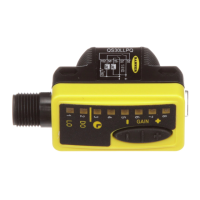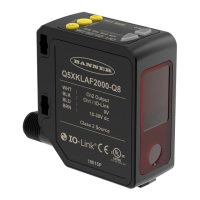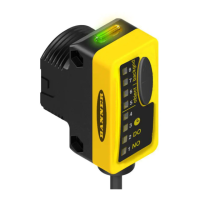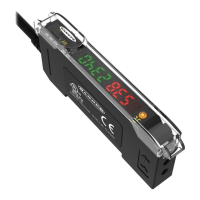• 10 milliseconds for 10, 15, 25, and 50 millisecond response speeds
•
1 millisecond for 1.5, 2, 3, and 5 milliseconds response speeds
Use
and to scroll through the values. Millisecond values do not include the decimal point; seconds values include the
decimal point.
•
1 to 999 ms (when
is selected, the 1 to 9 ms range is available for 1.5, 2, 3, and 5 ms response times)
•
1.0 to 90.0 s
Totalizer
The totalizer function changes the output only after counting a designated number of targets. After selecting this function,
or become available to define
the output duration and
or to
define required number of counts before the
output changes.
For
and , the default is 1 count.
For and , the default is 10 milliseconds. Use and to scroll through the values. Millisecond values do not
include the decimal point; seconds values include the decimal point.
•
1 to 999 ms (when
or is selected, the 1 to 9 ms range is available for 1.5, 2, 3, and 5 ms response times)
•
1.0 to 90.0 s
From Run mode, press SELECT to change the display to show the current totalizer count. Pressing SELECT again changes the
display back to the measured distance.
The totalizer count automatically resets after re-teaching the switch point distance or turning the sensor off.
3.2.9 Zero Reference Location
Use this menu to select the zero reference location. The default is , 0 = the front of the sensor. This menu is not available in
dual (intensity + distance) mode.
• —0 = the front of the sensor; the measurement increases further from the sensor
• —0 = maximum range; the measurement increases closer to the sensor
3.2.10 Shift the Zero Reference Location after a TEACH
Use this menu to select whether the sensor shifts the zero reference location based on the last TEACH process. The default is
, 0 = the front of the sensor or the maximum range. This menu is not available in dual (intensity + distance) mode.
• —Shift the zero reference location to one of the taught positions with each TEACH
• —0 = the front of the sensor or the maximum range, depending on the setting
This
figure illustrates three examples of how changes to the zero and shift settings affect what distance readout is shown on the
display when in 2-pt TEACH mode. Changes to the zero setting affect the direction in which the distance increases.
Q4X Stainless Steel Laser Sensor with Dual Discrete Outputs and IO-Link
14 www.bannerengineering.com - Tel: 763.544.3164

